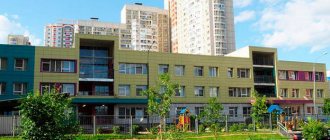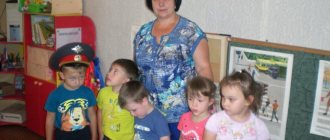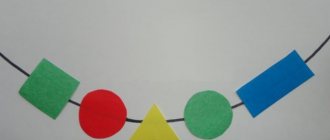Outdoor physical education middle groupmethodological development for physical education (secondary group)
OUTDOOR PHYSICAL EDUCATION INTERMEDIATE GROUP
Complex No. 1 (September).
Objectives: Teach children to run slowly; practice jumping on 2 legs on the court; develop spatial orientation. Teach children to breathe through their nose on the street.
1 hour (3 min). Walking with hand movements (up, to the side, towards the shoulders).
Slow running. Walking.
2h. (14 min). Game “Find your place” (with hoops, cubes).
Jumping on 2 legs moving forward from the edge of the platform to the middle.
Walking.
Outdoor game “Quickly to the house.”
3h. (3 min). Slow walking. Breathing exercises.
Complex No. 2 (September).
Objectives: To consolidate the ability to run in all directions, without bumping into each other, and to quickly respond to a signal. Continue learning to jump in place on 2 legs, landing softly on the front of the foot in regular shoes.
1 hour Walking is normal, with high knees. Running in all directions. Walking.
2h. Outdoor game “My funny, ringing ball.”
Game “Birds in the Nests”, “Bird Hen and Chicks”.
3h. Short run. Walking. Breathing exercises.
Complex No. 3 (October)
Objectives: Teach children to keep their back and head straight while running; Practice climbing stairs up and down. Develop running endurance in children. Teach children to breathe through their nose on the street.
1 hour Walking is normal, with arms raised up. Running is normal, scattered at a signal.
2h. Game “Run to the object” (running at a fast pace).
Climbing stairs with a side step up and down.
Outdoor game "Planes".
3h. Walk at a slow pace. Breathing exercises.
Complex No. 4 (October).
Objectives: To strengthen the ability to maintain balance when walking and running along a narrow path. Learn to throw the ball from the chest with 2 hands through a cord (other objects).
1 hour Walking is normal. Jumping on 2 legs moving forward. Run in all directions, at a signal, in a column.
2h. Walking and running along a marked path (15 cm wide).
Game exercise “Throw the ball over the cord.” Throwing the ball from the chest with 2 hands over a cord at a signal.
Outdoor game "Hares and wolves".
3h. Walk at a slow pace. Breathing exercises.
Complex No. 5 (November).
Tasks: Reinforce walking and running randomly when given a signal. Practice rolling the ball between objects. Learn to breathe through your nose.
1 hour Game "Tram". Walking and running in a column, scattered.
2h. Rolling the ball with 2 hands away from you between objects (cubes) or under arcs.
Outdoor game “Chickens in the garden” (“chickens” crawl under the rope in a group in the “garden”, “watchman” - the child catches up).
Game “Who can run faster” (running at speed to a landmark)
3h. Walk at a slow pace. Breathing exercises.
Complex No. 6 (November).
Tasks: Consolidate jumps while moving forward, throw the ball in front of you and catch it with 2 hands. In the game, consolidate the ability to run with acceleration and deceleration.
1 hour Walking is normal, with high knees, scattered while performing tasks (raise your arms up, bend down). Running is normal.
2h. Game exercise “Play, play, don’t lose the ball” (throwing the ball up).
Game exercise “From circle to circle” (jumping on 2 legs).
Relay race “Collect vegetables” (2 columns, cubes or other objects).
3h. Walk at a slow pace. Breathing exercises.
Complex No. 7 (December).
Objectives: Continue to teach how to walk and run in a “snake” fashion, and accurately perform turns around objects. Strengthen straight gallop, running with dodging, and jumping on two legs in outdoor games. Learn to breathe through your nose.
1 hour Walking is normal, like a snake. Running is normal, “snake” around objects.
2h. Outdoor games: “Horses” (straight gallop),
- “Trap” (running with dodging),
- “Jumping or not jumping” (children jump on 2 legs if this animal can jump, if not, they march in place).
3h. Walking at a slow pace around the kindergarten.
Complex No. 8 (December).
Objectives: Teach children to walk with mincing and wide steps; run a race, observing safety rules. Develop balance in children.
1 hour Walking is normal, with mincing steps and long strides. Running is normal.
2h. Game exercise “Who will be the first to reach the Christmas tree?”
Outdoor game “The Christmas tree and the forester” (the Christmas trees spin in place, they run at the signal “forester!” - the children freeze).
Game exercise “Follow the tracks” (walking “footprint” along a narrow path).
3h. Walking at a slow pace around the kindergarten.
Complex No. 9 (January).
Objectives: To consolidate different types of walking and running. To develop children's accuracy, eye, and coordination when throwing. Learn to breathe through your nose.
1 hour Walking is normal. At the signal, draw: an airplane, a horse, a bear, a hare. Running is normal.
2h. Sliding along icy paths.
Outdoor game “Horses” (children move in different ways: galloping forward, raising their knees high, running. At a signal, the “groom” catches up with the “horses”).
Game exercise “Who will knock the cube?” (throwing snowballs, bags or other objects at the cubes from behind the head).
3h. Walking at a slow pace around the kindergarten.
Complex No. 10 (January).
Objectives: Exercise children in walking and running in the snow, avoiding obstacles; Develop running speed in the snow while maintaining safety. Strengthen throwing snowballs (objects) from behind your head into the distance.
1 hour Walking is normal, avoiding objects in the area. Walking and running "footsteps".
2h. Outdoor game “Who will bring the ice cube faster?” (like “Who will run to the flag faster?”).
Throwing snowballs (objects, bags) from behind the head into the distance.
Game exercise “Penguins” (jumping on 2 legs with a bag between the legs, distance of at least 1 meter).
3h. Walking at a slow pace around the kindergarten.
Complex No. 11 (February).
Objectives: To reinforce different types of walking with children. Secure throwing at the target from the starting position. Continue learning to climb stairs in alternating steps.
1 hour Walking is normal. Walking “foot after trail”, waving your arms “the wind is raging”, at the signal - sit down, group. Running is normal.
2h. Game exercise “Who will get to the flag?” Throwing bags (other objects) from behind the head to the flag.
Climbing stairs up and down in alternating steps.
Outdoor game “Migration of Birds” (children are divided into 2-3 groups depending on the availability of aids. At a signal, each flock flies to its own aid: stairs, sandbox, bench).
3h. Walking at a slow pace around the kindergarten.
Complex No. 12 (February).
Objectives: Perform jumps on two legs, landing on the front of the foot, in regular shoes. Develop endurance in outdoor games.
1 hour Walking is normal, at the signal of the “horse” - walking with your knees high. Jumping on 2 legs. Normal running, at the signal - turn, run in the opposite direction.
2h. Game exercise “Jump over - don’t hit” (jumping on 2 legs between objects).
Outdoor game “Quickly from the circle” (children holding hands walk or run slowly, several children in the circle clap to the beat. At the teacher’s signal “Stop!” - children stop, raise their hands, children standing in the circle must run out of it to 3 scores. Those who did not make it in time are considered the losers).
Outdoor game “We are funny guys.”
3. Walk at a slow pace around the kindergarten.
Complex No. 13 (March).
Objectives: Continue teaching children to throw the ball with 2 hands from the chest. Develop coordination, eye, and endurance. Learn to breathe through your nose.
1 hour Walking is normal. Running in all directions “the rooks have arrived.” Run and stop at the signal. Walking.
2h. Game exercise “Throw the ball” (throwing balls in pairs from the chest with 2 hands).
Outdoor game "Tag".
Outdoor game “The sea is agitated.”
3h. Short run. Walking. Breathing exercises.
Complex No. 14 (March).
Objectives: Reinforce with children throwing objects at a target. To develop speed running and endurance in children.
1 hour Walking is normal, “giants” and “dwarfs”. Jumping on 2 legs. Running is normal.
2h. Game exercise “Who will knock down the cubes?” (throwing a ball, a bag from behind the head with the right and left hands from the main stance).
Outdoor game "Owl".
Game exercise “Runners” (speed running, distance 10 meters from the start).
3h. Running at a slow pace around the kindergarten. Walking. Breathing exercises.
Complex No. 15 (April).
Objectives: To develop physical qualities in children in relay races. Learn to breathe through your nose while running.
1 hour Walking is normal, with long steps “through puddles”, jumping on 2 legs. Normal running, hopping.
2h. Relay races:
- Pass the ball over your head in a column.
- Whose team will “snake” around objects faster?
- “Kangaroo” (jumping on 2 legs with a bag between the legs).
- “Cars” (hoop running)
- “Steam Locomotive” (running, “attaching” other children from the team)
- “Whose team will build faster?”
3h. Running at a slow pace around the kindergarten. Walking. Breathing exercises.
Complex No. 16 (April).
Objectives: Teach children to jump on 2 legs on a skipping rope; hit the ball against the wall with 2 hands. Develop endurance when running.
1 hour Walking is normal, with clapping overhead. Jumps. Running at a slow and fast pace.
- 2h. Jumping rope, on 2 legs (as shown by the child or teacher).
- Hitting the ball against the wall (pavilion) with 2 hands from the chest.
- Sedentary game “Stop” (children in a circle, one throws the ball and calls the child’s name, he must have time to catch the ball, the rest scatter, the driver, having caught the ball, throws it over the legs at any child, the greasy child becomes the driver).
3h. Run at a slow pace. Walking. Breathing exercises.
Complex No. 17 (May).
Objectives: Continue to teach children how to operate with the ball. Develop coordination and eye.
1 hour Walking is normal, between objects. Jumping on 2 legs. Running is normal, “snake”.
2h. "Ball School"
- Hitting the ball on the ground with the 1st hand.
- Tossing and catching a ball with 2 hands.
- Hitting the ball against the wall with 2 hands.
3h. Running at a slow pace around the kindergarten. Jumping. Walking. Breathing exercises.
Complex No. 18 (May).
Tasks: Reinforce with children throwing objects at a target, jumping on 2 legs. Develop physical qualities. Learn to breathe through your nose.
1 hour Walking as usual, forming pairs. Jumping, jumping. Running in pairs.
2h. Throwing a ball (bag) at a target from behind the head from the main stance.
Outdoor game “Homeless Hare” (children “hares” in drawn circles, the hunter catches up, the “hare” runs into any circle, the previous “hare” becomes “homeless” and the hunter catches up with him).
Game exercise “Jump over the stream” (jumping on 2 legs over a line).
3h. Running at a slow pace around the kindergarten. Walking. Breathing exercises.
A set of walking exercises for middle group children in kindergarten
A set of walking exercises for children 4-5 years old “Strong and fast!”
The complex exercises in their motor culture are simple and accessible for children 4-5 years old; the material can be useful to physical education instructors, educators, and parents.
Goals: to develop in children a desire to perform exercises together with their mother; increasing motor activity of children. Objectives: maintain and strengthen the physical and mental health of children; promote the development of the musculoskeletal system; create conditions to satisfy children’s natural need for movement.
A walk in the fresh air will bring joy and pleasure to everyone. Especially if you combine it with casual, mischievous gymnastics. Hiking and cycling, playing with a ball, swimming are useful for strengthening the muscles and joints of the legs - the whole family can do this. Special gymnastics for the legs is also of great importance. This set of exercises is suitable for outdoor training, but it can also be performed at home. A mandatory requirement for a child’s outdoor shoes is that they must be lace-up and match the size of the foot. In poorly secured shoes, a child runs the risk of twisting his ankle, and in boots or sneakers with a reserve, he will stumble. So, if the equipment is ready, and the weather allows you to go for a walk without umbrellas and jackets, then hit the road! Enjoy a walk together, watch summer nature with your baby, and do some fun gymnastics. Have an interesting holiday! “Squat” The child puts his hands on his belt, squats, stands up, puts his right foot on the heel, on the toe, then puts it on the left. He squats again, stands up, puts his left foot on the heel, on the toe and next to the right. “That’s how low” You need to pull the rope or ribbon at the level of the child’s chest. The baby stands at a distance of two meters from the rope and begins to walk towards it, gradually crouching until he passes under the rope. It is important to keep your back straight! “We are changing!” Mother and child stand facing each other, holding a toy in their hands. They jump with side steps to the right, exchange toys, turn their backs to each other, jump with side steps to the left, exchange toys (without turning to face each other). “Behind the tail!” You will need a ribbon or rope 1 meter long. The mother attaches a “tail” to the child’s belt. The baby runs away from his mother, and she catches him by the tail. When he catches it, they change roles - the mother puts on a ponytail and runs away, and the child catches it. “Pistol” Any small stump will do. The child places his right foot on it, slowly squats on his left leg (as deep as possible). Then he changes legs. At this moment, the mother secures the baby from behind. “Wave” Mom and child hold hands and take turns squatting. First slowly, then quickly. You can invite everyone to the game - if everyone takes turns squatting, you will get a lot of “waves”.
We recommend watching:
Final lesson for the middle group on the topic: Summer Scenario of a leisure activity in kindergarten in the middle group “In search of treasures” Health path in kindergarten. Abstract Walk as a means of development of preschool children in the context of the implementation of the Federal State Educational Standard for Education
Similar articles:
Observations of living and inanimate nature in the younger group of kindergarten
Didactic tasks for a walk in kindergarten. Junior preschool age
Summary of the walk in the preparatory group “Water Observation”
Summary of the walk in the preparatory group “Observation of snow and ice”
Walks in the preparatory group. Card file with goals for May
Techniques of various types of walking
Basic types of walking
for children of the younger group
— Walking is normal.
The foot is placed on a support from the heel, then rolls over the foot onto the toe into a push-off (if possible with the leg straightened at the knee). The movements of the arms are calm - the arms bent at the elbows alternately rise forward no higher than chest level, then are pulled back with the elbows up, the hand is approximately at waist level. The head is raised, the shoulder girdle is not tense, the stomach is tucked.
— Walking on toes.
Performed on straighter legs. The steps are short, the body is straightened and taut. The foot is placed on the forefoot (on the toes), the heel does not touch the surface. Hand movements are insignificant, they are somewhat relaxed. They can be placed on your belt or behind your head. At the same time, the shoulders are lowered, the posture is relaxed.
— Walking with high knees
. The movements are energetic and clear. The foot is placed first on the front part, then on the entire foot. The steps are short but confident. The leg bent at the knee rises forward and upward. The thigh takes a horizontal position, the shin forms a right angle with the thigh, the toe is pulled down. Active movements of the legs are consistent with the movements of the arms, the hands are clenched into fists. Little progress has been made. The body is straight, the head is raised.
for middle group children
— Walking on your heels.
The foot is placed on the heel, the toes are raised up. At the same time, you should not turn it too far to the sides. Arm position: elbows bent and clasped behind the back. Simulation of movements: "Penguin"
— Walking on the outer arches of the feet.
The torso is naturally straightened, the feet are shoulder-width apart, the legs are straight, the arms are bent at the elbows and located at chest level, the hands are clenched into fists, the chin is tucked, the gaze is directed forward. Shift your body weight to the inside of your right and left feet. Walk at a moderate pace.
— Walking in a half squat
. Performed on bent knees. When walking, the leg is placed on the forefoot. You should try to keep your back straight. Hands move freely. When walking, they can be placed on your belt, to your shoulders, to the sides, or behind your back.
— Walking with small and wide steps
. Movements are somewhat slow. The usual coordination of movements of the arms and legs when walking is preserved. The foot is placed by rolling from heel to toe. The approximate step length is different for children of different ages (32-35 cm at 2 years, 55-60 cm at 7 years). When performing this type of walking, you should not excessively increase the length of steps, as this can lead to disruption of the coordination of movements that is developing in children.
— Walking while stepping over objects (35-40 cm
). The teacher shows and explains that you need to step over alternately with your right and left feet without stopping, without pausing. The task is completed at an average pace.
for older children
— Walking on the outside of the foot.
The torso is naturally straightened, the feet are shoulder-width apart, the legs are straight, the arms are bent at the elbows and located at chest level, the hands are clenched into fists, the chin is tucked, the gaze is directed forward. Shift your body weight to the outside of your feet with your right and left legs. Walk at a moderate pace.
— Walking with side steps.
Can be performed forward, backward, to the right and left. The step begins with any leg: one is brought forward, the other is placed next to it. Both feet end up together, their heels touching each step. You should not turn the foot of the attached leg with the toe inward. The hands do not take part in the movement; it is more appropriate to place them on the belt. This type of walking is especially good to perform with music, given its different nature: with a march - clearly, without noticeable bending of the legs at the knees; to dance music - softly, springing on one or both legs, etc.
— Heel-to-toe walking
. This type of walking is performed by clearly placing the foot on the heel, smoothly and at the same time energetically rolling onto the toe, slightly springing at the same time and trying to rise higher. Hand movements are free, relaxed, with some emphasis (stopping) at the moment of transition to the toe
— Walking backwards
. One leg is placed back on the forefoot or on the entire foot at once. The push is made by the heel of the other foot or the entire foot at the same time. Coordinated movements of arms and legs are difficult to perform
For children of the preparatory group
— Walking in different formations
(in a column one by one, in pairs, in fours, in a circle by two, in a line.)
— Walking in combination with other types of movement.
— Gymnastic walking.
It is performed by placing the foot on the toe with a wider step, the foot is fully supported.
— Walking with a cross step.
In this type of walking, one leg is brought forward and placed in front of the other slightly to the side. Little progress has been made. The leg should be placed straight and on the entire foot. It is advisable to keep your hands on your belt, since their active movements can lead to excessive rotation of the torso and impair coordination of movements.
— Walking with lunges.
The leg brought forward is placed with the knee bent over the entire foot. The leg remaining behind stands on the toe (if possible, it should be kept straight). The push is made with the toe of the standing leg behind
- Walking backwards
. One leg is placed back on the forefoot or on the entire foot at once. The push is made by the heel of the other foot or the entire foot at the same time. Coordinated movements of the arms and legs are difficult to perform.
— Walking in a squat.
Performed with legs completely bent at the knees. When walking, the entire foot is placed. You should try to keep your back straight. Hands move freely. When walking, it is better to keep your hands on your knees.
— Walking with side steps.
Can be performed forward, backward, to the right and left. The step begins with any leg: one is brought forward, the other is placed next to it. Both feet end up together, their heels touching each step. You should not turn the foot of the attached leg with the toe inward. The hands do not take part in the movement; it is more appropriate to place them on the belt. This type of walking is especially good to perform with music, given its different nature: with a march - clearly, without noticeable bending of the legs at the knees; to dance music - softly, springing on one or both legs, etc.
— Walking with your eyes closed.
Performed in small steps, deviations from the straight direction are usually observed.
E.N. Vavilova, “Teach to run, jump, climb, throw,” M., 1983.




